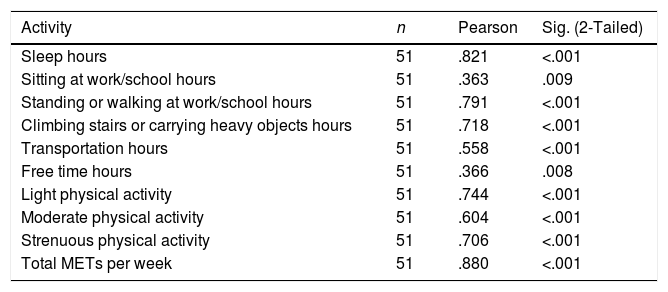The measurement of physical activity and sedentary behavior is challenging, as daily life includes activities of varying intensity and duration.1 Sedentary behavior is defined as “any waking behavior characterized by an energy expenditure of ≤1.5 metabolic equivalents (METs) while in a sitting, reclining, or lying posture”.2 A considerable amount of current scientific evidence linking sedentary behavior to morbidity was obtained from studies based on self-report questionnaires, and these remain the most practical, rapid, and feasible instruments in large-scale studies. Until now, available evidence has not been sufficient for establishing an ideal self-report instrument to precisely measure sedentary behavior,3 and achieving both linguistic and conceptual equivalence upon translation has been a challenge for each country.4 The aim of this study was to test the validity and reliability of the Physical Activity Scale, version 2.1 (PAS-2.1), translated and culturally adapted to Mexican Spanish (PAS-2.1S). The PAS-2.1 was developed in Denmark and subjected to content and criterion validation against maximal oxygen consumption (VO2max) and accelerometry.5
MethodsOnce the PAS.2.1 was translated and back-translated, face validation was performed through interviews with adults of varying ages and levels of education, then, we achieved concurrent criterion validation by comparing scores from the PAS-2.1S with those of the International Physical Activity Questionnaire Short Form (IPAQ-SF). We use the criterion of 10 participants for each item to determine our sample size,6 applying the two questionnaires to 104 volunteer health sciences students, all of whom signed informed consent. To evaluate the reliability of the scale with respect to response stability over time, we performed a test–retest, administering the PAS-2.1S to the same 51 subjects in two different occasions, 3 weeks apart, Finally, to evaluate discriminant validity, we compared the number of hours and METs reported on the PAS-2.1S of 25 students classified through our study as sedentary with 26 students from the School of Physical Activity and Sports, whom one would expect to be much more active.
ResultsFor face validity we performed 13 interviews in participants with an age range of 25–67 years old and 6–17 years of education. Analysis of the transcripts indicated that changes were necessary when discussing the lifestyle of the Mexican population, such as: regarding physical activity in the workplace or school, we exchange the clause “not working” to “include routine physical activity during unpaid domestic work”. Failing to do so would underestimate the activity of many women who dedicate themselves to unpaid domestic work. Also, item 5 dealing with physical activity expended in transportation between home and school or work, we asked how much time the participants spent sitting traveling, because in previous surveys a mean time spent sitting during transportation of 1.7 (±.99) hours per day was identified, with a maximum of 6h).
We tested convergent validity by comparing the hours dedicated to different levels of physical activities in the questionnaires PAS-2.1S and IPAQ-SF answered simultaneous by 104 participants, finding a strong positive correlation between the two scales: with strenuous activity (r=.773, p<.001), moderate activity (r=.542, p<.001), sedentary activities (r=.507, p<.001); and a weak correlation for light activity. When comparing total sum of METs of all four categories we observed r=.659 (p<.001).
We compared the number of hours spent in each type of activity between sedentary and sporting student groups to test discriminant validity in extreme groups. We observed statistically significant differences in all activities (p<.001), except for transportation to and from school and climbing stairs. Table 1 shows the PAS-2.1S test–retest, with a strong correlation in almost all activities and in the MET/hour/week.
Test–retest of PAS-2.1S administered to the same participants at a 3-week interval (2018).
| Activity | n | Pearson | Sig. (2-Tailed) |
|---|---|---|---|
| Sleep hours | 51 | .821 | <.001 |
| Sitting at work/school hours | 51 | .363 | .009 |
| Standing or walking at work/school hours | 51 | .791 | <.001 |
| Climbing stairs or carrying heavy objects hours | 51 | .718 | <.001 |
| Transportation hours | 51 | .558 | <.001 |
| Free time hours | 51 | .366 | .008 |
| Light physical activity | 51 | .744 | <.001 |
| Moderate physical activity | 51 | .604 | <.001 |
| Strenuous physical activity | 51 | .706 | <.001 |
| Total METs per week | 51 | .880 | <.001 |
Note. METs: unit of measure of metabolic equivalents (amount of energy used by an individual at rest or during physical activity)7.
In this study, different aspects of validity and reliability of the PAS-2.1S were tested. The cultural adaptation was one of the most challenging tasks. Finally, we consider that an eye-catching, easily applicable, adapted Mexican–Spanish version of the PAS-2.1S scale now exists with acceptable validity and reliability, that may be utilized in any other Spanish-speaking population with similar behaviors.







